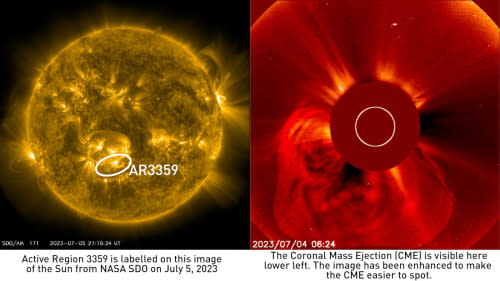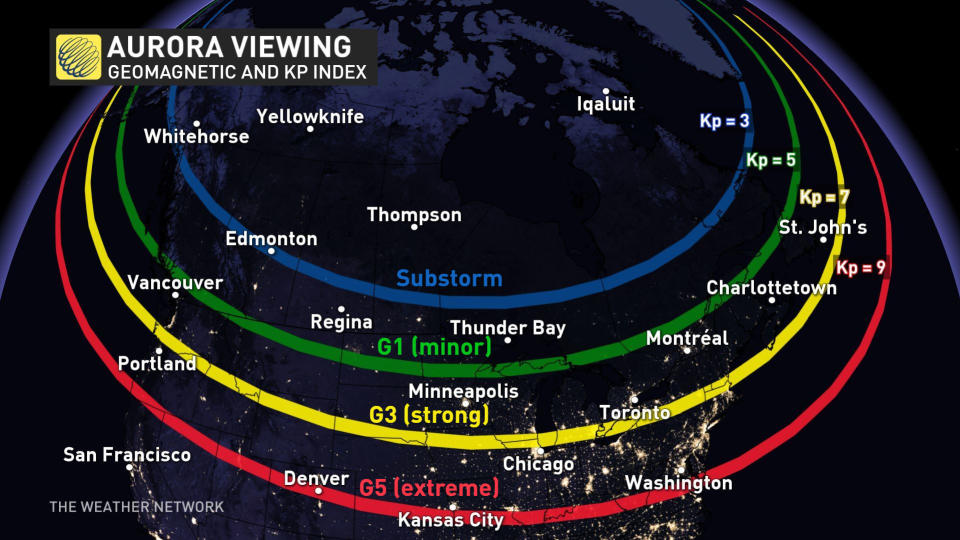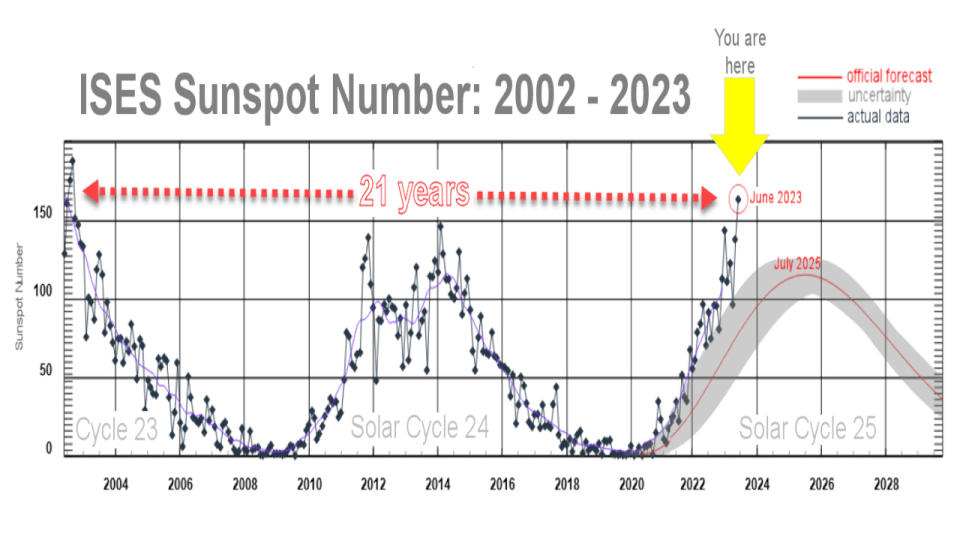Solar storm could spark auroras across Canada Friday night

Eyes to the sky for the start of the weekend. Skywatchers across Canada may see displays of the Northern Lights on Friday night due to a passing solar storm.
Monday night, a large active region on the Sun, which solar scientists have named AR 3559, released an immense cloud of charged solar particles out into space — a Coronal Mass Ejection, or CME.

The left panel shows the view of the Sun from NASA's Solar Dynamics Observatory on July 5, highlighting AR 3559. The right panel is the view of the solar corona from NASA/ESA's Solar and Heliospheric Observatory (SOHO) from July 4. Credit: NASA, NASA/ESA
This 'solar storm' is moving fairly slowly through space, taking roughly three days to cover the 150 million kilometres between the Sun and Earth. However, it is aimed almost directly at us.
Forecasters with NOAA's Space Weather Prediction Center are expecting the CME to arrive here sometime during the day on Friday. As it passes, the magnetic field carried by this solar storm will likely result in a minor disturbance in Earth's geomagnetic field, causing what's known as a geomagnetic storm.
NOAA SWPC has issued a Geomagnetic Storm Watch, anticipating G1 storm levels Friday afternoon (EDT), "with a chance for G2 storm levels if more favorable conditions are observed."
Although very strong geomagnetic storms have been known to cause problems with orbiting spacecraft and satellites, and with power grids on the ground, weak and even moderate geomagnetic storms most often result in vibrant displays of the Aurora Borealis, aka the Northern Lights.
The timing of the event will be most important for who will see the auroras. If the geomagnetic storm occurs during the day for Canada, any displays that do appear will be centered over northern Russia and northern Europe. However, if the timing of the storm is later than expected, the effects persist until nightfall, or the storm reaches G2 or higher levels, aurora chasers across Canada should keep an eye on the northern sky.

Who has a chance to see the auroras depends on how strong the geomagnetic storm is. As indicated on the map above, during a G1 (minor) geomagnetic storm, auroras can typically be seen as far south as the green line. This includes parts of northern Atlantic Canada, northern Quebec, northeastern Ontario, western Ontario, the Prairies, and the B.C. Interior.
If storm levels do reach G2 (moderate), the auroras will likely push farther south, to be visible between the green and yellow lines. This includes all of Canada except the southern regions of Nova Scotia and southwestern Ontario.
Strong Solar Cycle
Roughly every 11 years, the Sun begins a new 'solar cycle' where sunspot, solar flare and coronal mass ejection activity increases for a period of about 5-6 years, reaches a maximum, and then it ramps down again for another 5-6 years after to a minimum.
The latest solar cycle, number 25 since record-keeping began, started in December of 2019, and it is turning out to be a very active one.
According to Dr. Tony Phillips: "Solar Cycle 25 wasn't expected to be this strong. When it began in Dec. 2019, forecasters believed it would be a weak cycle akin to its immediate predecessor Solar Cycle 24. If that forecast had panned out, Solar Cycle 25 would be one of the weakest solar cycles in a century."

This graph tracks solar cycle progression, through sunspot count, from 2001 through 2023. As the notations from Dr. Phillips indicate, the current sunspot count is greater than the past 21 years of activity. Credit: NOAA SWPC/Dr. Tony Phillips
"Instead, Solar Cycle 25 has shot past Solar Cycle 24 and may be on pace to rival some of the stronger cycles of the 20th century," Phillips wrote on spaceweather.com. "The last time sunspot numbers were this high, the sun was on the verge of launching the Great Halloween Storms of 2003, which included the strongest X-ray solar flare ever recorded (X45), auroras as far south as Texas, and a CME so powerful it was ultimately detected by the Voyager spacecraft at the edge of the solar system."
Solar cycle 25 is definitely outperforming the forecast from back in 2019. There is even some indication that solar maximum will not happen in 2025, as originally forecast. Instead, this cycle could max out early, reaching peak activity by the end of this year or in early 2024.
Back on March 23-24, a solar storm sparked the strongest aurora displays we've seen in years. They were even brightly visible in southwestern Ontario, which is quite rare.
It's unlikely that we'll see anything like that again until the fall, when the phenomenon known as 'equinox cracks' returns. Equinox cracks are connections that form between the magnetic fields of Earth and the Sun, which allow more solar particles to be captured by Earth's magnetic field, causing stronger displays of the Northern Lights. As the name implies, these connections most often occur around the equinoxes, typical in September and October, and in March and April.
Tips for aurora viewing
Aurora watching can be challenging.
At times they can put on spectacular displays overhead, bright enough to be clearly seen with the unaided eye. In other cases, they can hang out just near the horizon, far to the north. Many times, you can just barely notice that they're there, and it requires long-exposure photography to draw out the details.
Additionally, they can be anything but consistent, as they brighten and dim, or even appear and disappear, in the blink of an eye.
Since clear skies are essential for seeing the Northern Lights, the first thing to check before going out is your local weather forecast.
Also, even the clearest skies will likely not help if you're viewing from inside a large urban centre. City light pollution affects our night vision, and thus can easily spoil the show. The best viewing potential can be found far away from urban sprawl.
Next, be patient.
The human eye needs time to adjust to the dark. So, give yourself about 20-30 minutes away from any bright lights (including smartphone screens) to start. Looking up at the stars and planets can easily make that time go by quickly. Then, turn your eyes to the north. It's possible that the auroras may not be there at first, but if you give it some time, you could see something amazing.
Also, an excellent way to detect if there are auroras shining overhead is to use your phone camera. Since they may be too faint for your eyes to immediately pick out, the camera's sensitivity to faint colours may provide your first indication that something is going on. If you note any unusual hints of green or pink, switch the camera into Night mode, hold it steady (maybe rest it on a fence), and take a picture to see if it captures anything.
(Thumbnail courtesy Joe Gilker, who uploaded this image of the Aurora Borealis from Camden Lake, on October 13, 2016, into the Weather Network's UGC Gallery)

